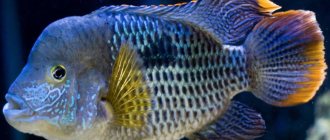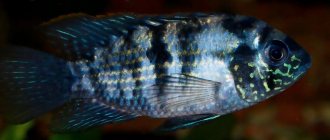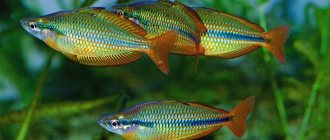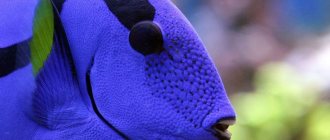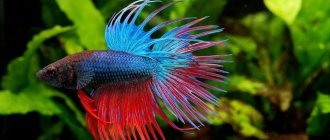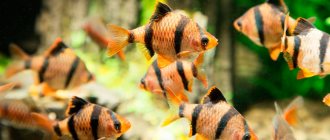Acaras are fish with an unusual pearlescent coloration of the gills and stigma. They are not only amazingly beautiful, but also have a pronounced character. These cichlid species are curious and love to watch life behind glass. Many of them recognize their owner. The most popular among aquarists are: blue-spotted acara, red-breasted acara, turquoise, electric blue, zebra, maroni acara and neon. In total, today there are more than 30 types of cancer.
Acaras live in river water in South America. The homeland is considered to be the central part of Peru and western Ecuador. These cichlids prefer rivers with slow flows, plenty of shelter and rich vegetation. Acaras are micropredators and feed on insects, larvae, invertebrates and small fish.
Description
The body of the fish is high, slightly flattened on the sides and elongated in length. The head is large with a convex forehead, the eyes are larger than average, and the lips are thick. The dorsal and anal fins are pointed, the caudal fin is rounded. The color can be of various shades: from bluish-blue to reddish-burgundy.
Sizes vary depending on the species. Zebra, one of the smallest cancers, reaches 4-5 cm in length. Blue spotted and turquoise acara can grow up to 25 cm in aquarium conditions.
Males are more brightly and attractively colored. Usually in females there are only inclusions of various shades. The fins of males are longer and the body is larger. A characteristic feature of males is a noticeable fatty bump on the head, which appears already in adulthood.
Aquarium
Basic dimensions are at least 150 cm x 45 cm.
Ideally, the aquarium should be furnished with a soft sandy substrate and driftwood, as well as a few large flat rocks that can serve as potential spawning sites. If there are other fish in the aquarium, arrange the decor to create as many visual barriers as possible. While this is unlikely to completely calm them down, it will at least help dispel aggressive behavior.
Floating plants that provide shade are also a good idea, but rooted plants are less suitable. Species that can be attached to decoration, such as anubias or Thailand fern, have a much better chance of survival.
Water parameters:
Temperature: 23 – 28° C (in nature 20–25° C) pH: 6.5 – 8.0 Hardness: 5 – 25° dGH
Sensitive to deterioration in water quality, so use effective biological filters as well as a strict maintenance regime.
Akara in nature
The historical homeland of cancer is considered to be reservoirs located in the northwestern part of Peru and the Rio Esmeraldas River basin. They are also found in South America, Central Colombia, Brazil and some other countries, preferring bodies of water without strong currents with rich vegetation and multiple shelters.
Cancers have been kept in aquariums since the seventies of the last century, and today they are one of the most sought-after cichlids among fish lovers.
Conclusion
The cichlid fish is not shy, it quickly gets used to and recognizes its owners. If someone approaches, they swim up to the glass to see the person. There are times when cancers even allow themselves to be stroked. Although the aquarium fish is unpretentious, it is recommended that experienced aquarists keep it, since it will be a little more difficult for beginners to provide the necessary conditions for the cichlid. However, if you get this aquarium fish, it will delight you with its beauty for a long time, and you will be very happy with the fish!
Previous
Varieties of Betta fish (betta, aquarium betta, veil): maintenance, care in the aquarium (water temperature)
Next
Varieties of Molliesia reproduction: fry, pregnancy, childbirth, breeding (spawning) of aquarium fish, what to feed at home
Great article 0
Appearance
Acaras are fish with a large and elongated body, growing up to 30 cm in length. A distinctive feature is the presence of a head with a large convex forehead, thick lips and expressive eyes. The anal and dorsal fins are elongated. These fins, as well as the tail fins, often have edging.
The coloration of young individuals is more than modest: the body color is gray with dark stripes. But as they grow older, the full potential of color is revealed, and the akara becomes extremely picturesque.
Turquoise acara. Appearance.
The colors can be very varied. A common sign is the presence of shiny spots all over the body. Males are larger than females and have longer fins. Females are more modestly colored, not as bright, and their fins are more rounded. At the age of about 5 years, a wen may appear on the male’s head, which frightens some aquarists, but this phenomenon is normal and is not associated with disease.
First a little history
Albert Karl Ludwig Gothelf Günther
(1830-1914) - a German zoologist, known to all aquarists for his work on the creation of an 8-year-old catalog of fishes (“Catalogue of fishes”), first gave a complete description of the turquoise acre back in 1860.
In the chapter dedicated to the “green terrorist”, he clearly attributed this fish to the cichlid family - Cichlidae, and said that the fish came to Europe from South America, where it lived freely in the rivers of Peru and Ecuador, preferring rocky-sandy areas, poorly penetrated by the sun shallow waters. Hiding under large rocks and dark driftwood, this iridescent aggressor attacked larvae, insects, small invertebrates and other smaller fish.
In his writings, Albert Gunther made no difference between the turquoise acre Andinoacara rivulatus and the blue-spotted acre Aequidens pulcher, classifying them as the same species.
For beginning fish farmers, these differences are so insignificant that it is not worth dwelling on them in detail.
Content
Proper maintenance includes a clean living environment. You need to change the water in the aquarium at least once a week. Filtration and aeration are also necessary. Water should be changed at the rate of 20% of the volume of the entire aquarium. It is necessary to pour in fresh water very gradually, literally drop by drop. Otherwise, cichlids may get sick
.Akars need large amounts of water. Dwarf cichlids (such as the zebra) need to purchase an aquarium with a volume of at least 100 liters per couple, and large cichlids (such as the turquoise cichlid) will need a minimum of 200 liters for two. Then they will grow up to be healthy fish with bright colors. An insufficient aquarium size will lead to aggression even in peaceful cichlids.
But caring for cancer is not limited to this. The acidity and hardness of water is of great importance for them. Too low or high values lead to the death of fish. At the pet store you can buy special devices for measuring water parameters in an aquarium. Acidity and hardness must be checked daily. And be sure to measure the level of all parameters in fresh water when adding it to the aquarium.
There are various chemicals that help achieve the required values. But it is better to take care of your fish using natural methods. For example, some aquarium plants reduce water hardness (elodea, hornwort). It is also recommended to use filtered rainwater or melt water for the aquarium (after freezing it and then heating it to the desired temperature).
Cichlids are quite fastidious in caring for them. But they are also very picky about their tankmates. If you nevertheless decide to add fish compatible with them to the acara, this should be done only at the very early age of the cichlids.
Novice cachlid lovers may not know that these fish cannot be kept in the same aquarium with snails, as the cichlids will simply eat them.
Fish of this species love to dig in the ground, so stones with sharp corners cannot be used. Akara might get hurt. Be sure to create all kinds of shelters in the aquarium in the form of driftwood, broad-leaved plants, and mounds of stones. Cichlids need secluded places in their habitat.
Aquarium plants are best placed in the corners and along the back wall to give the fish more space to swim freely. Please note that large cichlids, digging in the ground, uproot plants, so it is necessary to secure them in separate containers.
Possible diseases
Fish of this species have a fairly strong immune system, but cancers are especially susceptible to some fungal infections.
| Name of the disease | Signs | Method of treatment |
| Nitrate poisoning | The color fades, the fish does not eat, does not sink into the water column | It is necessary to completely replace the water and calcinate the soil. To eliminate nitrate compounds, you can purchase special products at a pet store. |
| Ichthyophthiriasis | White spots developing into ulcers | Sulfur preparations containing sulfur in their composition are effective. It is important to rinse the filter and calcine the substrate. |
| Fin rot | Ulcerative erosions on fins and body | It is necessary to disinfect the aquarium and water using a manganese solution. |
Akara is a real decoration for any aquarium. Despite the nature of the fish of this species, they get along well with many cichlids. It is very important to provide the fish with enough space to avoid excessive aggressiveness.
Types of cancer
As already noted, acara are widespread; there are many varieties of these original fish. Some species of cichlids are more popular than others among aquarists, and they can be found for sale more often.
Akara turquoise
Among other representatives of the species, it is distinguished by its large size and variegated color. Her body is covered with turquoise scales with silver and pearlescent tints. Turquoise cancers are similar in appearance to diamond cichlazomas; they are often compared and even confused. Yes, these fish have certain similarities, but they are still different creatures. Aquarium hobbyists can keep both of them - they get along well in the same tank.
The turquoise acara has a reputation as a bully, but experts say that the character and behavior of this inhabitant of the underwater world largely depends on the quality of care and suitable company. If some nuances are observed, the fish will not show aggression.
Blue acara
This type of cancer has recently lost some of its former popularity. This is due to the fact that every year more and more colorful and attractive fish of the cichlid family are bred. On average, the length of blue acara is 12-14 cm, females are inferior to males in size. In addition, males have larger fins and often have a characteristic growth on their head, but it is not as noticeable as that of the turquoise acara.
Blue Acaras are also known as aggressive fish. But again, if the owner provides his charges with everything they need and selects a suitable company, there is no need to worry - the blue acara will behave peacefully. You should not provoke this fish into aggression by placing it in the same container with predatory fish.
Other representatives of the cichlid genus with small blue acaras should not be stocked. They will also not be able to find a common language, and conflict situations cannot be avoided.
Acara spotted
These fish are familiar to many aquarists; their name in Latin sounds like “beautiful”. The spotted fish is often confused with the turquoise fish, but it is slightly smaller in size. The maximum spotted acara grows up to 20 cm; among the turquoise ones, 30-centimeter individuals are also found. Spotted males also have a bump on their head, but it is not as noticeable as their turquoise counterparts.
The fish of this species has a grayish body with blue tints; it has two black vertical stripes and a scattering of bluish sparkles. It is the spotted cancer that is recommended for beginners, as it is more unpretentious than all the others. It is enough to provide it with high-quality water and food to keep the fish healthy. If a pair is formed, then you won’t have to wait long for spawning and offspring.
This type of cichlid has a peaceful and calm character; it is quite easy to find neighbors for them, including close relatives. They are not in the habit of attacking and bullying those who live side by side with them. Of course, the presumptuous inhabitants will be punished, but usually the Akaras simply drive them away, without fights or bloodshed.
During the spawning period, the spotted crayfish family becomes more aggressive and easily excitable, this is due to the fact that they need to take care of their offspring.
Neon acara
Small representatives of the species, with bright scales of a rich pearlescent color. The areas of the head and upper back are covered with golden scales. Neon acara is a calm, peace-loving fish, but during spawning its temperament changes. Standing up to protect their offspring, parents react aggressively to neighbors swimming nearby. In addition, your partner may also get a beating.
It is advisable to consider fish of modest size as neighbors, since larger cichlids can profit from small “relatives”.
Akara electric blue (aka Nannakara neon)
Bright representatives of the species, having bright blue, sparkling scales. The front part of the body shimmers in orange. Such an inhabitant becomes a real decoration of the aquarium - stunningly beautiful, bewitching.
Electricians are not aggressive and can get along with almost any living creature. Even during spawning, they conflict only if their offspring are in real danger. Keeping these fish is much more difficult than other cancers. But all the difficulties will pay off with interest - a luminous miracle will live in the aquarium.
Red-breasted Acara
The sternum and lower part of the head are covered with deep red scales. Because of this, the fish got its name. The main color is in the green and golden palette. The spawning of the red-breasted acar is beneficial - its color becomes brighter and deeper.
This cichlid is unpretentious, does not need large territories, but will actively defend its area against curious and impudent neighbors.
Akara Maroni
The color of these cichlids consists mainly of yellow, red and olive shades. They have a black stripe around their eyes, and there is also a black spot near the dorsal fin. On each scale there is a speck of rich brown color.
Like the red-breasted acara, Maroni has the unique property of changing color depending on its mood. These beautiful fish are timid and peace-loving; when they see danger, they prefer to flee and hide in a secluded place rather than enter into conflict.
Who do they get along with?
Acara's livability largely depends on the size of their living space. This turquoise fish is especially aggressive towards individuals of its own gender and species, so it can easily start a war with it. Often females that stand out for their particular pugnacity even have to be resettled. As for animals of other species, it is quite possible to add fish of the same size as acaras and capable of fending for themselves into a large jar.
Good neighbors for the turquoise acara will be:
- cichlids of equal size;
- small cichlazomas;
- hybrid red parrots;
- catfish.
Dwarf cichlids, including African cichlids, angelfish and any small peaceful fish are not suitable for housing.
Feeding
Food should be ground beforehand, especially when feeding dwarf cichlids and all types of cichlids at an early age. Being micropredators, these fish grab food and swallow it whole. When feeding a whole tubifex or bloodworm, pieces of this food even stick out from the fish’s gills. After such a meal, the fish gets sick and dies. This type of fish should not be fed beyond measure, as they overeat and begin to get sick. It is best to give them small amounts of food once or twice a day. It is recommended to follow a feeding regime for cancer.
Large species of cichlids with age can already eat food entirely without harm to their health.
It is recommended to alternate different feeds. The optimal food for these cichlids is: hake, cod, navaga, pollock, pink salmon, squid, crab, octopus, live or frozen cyclops, bloodworms, brine shrimp, washed and chopped tubifex, daphnia, beef heart, beef liver, bell pepper, scalded lettuce, carrots, specialized dry food.
When feeding fish, do not overuse meat of animal origin. Heavy fat can negatively affect the condition of cancer.
When purchasing food for cancer, you should be careful. For example, you should not buy frozen bloodworms, since most often this product may be contaminated. It is better to purchase a fresh analogue, making sure that there are no contaminants on the worms.
What to feed
Green terror are predatory, meat-eating fish. In the wild, carnivorous fish species feed on insects and their larvae, crustaceans and other fish.
For their survival, species belonging to the carnivore group require higher levels of proteins in their diet, which typically contains 45%-70% protein.
But, oddly enough, predators also need some vegetables in their diet, but unlike herbivorous fish, plant foods should not be the main food for them.
It should also be remembered that for the growth of healthy bones, scales and tissues, vitamins and minerals must be added to their diet.
Excellent sources of protein include bloodworms, enchytraeus (white worms), tubifex worms and microworms, all of which are available in live, frozen or freeze-dried form.
In addition, enchytraeus also serve as excellent suppliers of lipids, which are necessary for the proper functioning of cells and maintaining body temperature.
Forage fish can be an excellent addition to the diet of larger carnivorous fish such as Cichlids.
Guppies and Goldfish are the most commonly used forage fish due to their small size and low cost.
However, we should not forget that they can be carriers of dangerous diseases and therefore it is best to quarantine them for a week.
Artemia, due to their high water content, have low nutritional value, however, as a source of high-quality protein, they are incomparable.
Beef heart is an excellent source of protein and can serve as a healthy food for young fish that require high protein food to grow. But because it contains about 18% saturated fat, it can have negative effects on the kidneys and gastrointestinal tract over time, so it should be used with caution.
Breeding
Acaras spawn in the same way as all cichlids. This can happen both in the spawning area and in the general reservoir.
The breeding season is characterized by aggressive behavior of fish.
It is not necessary to create any additional conditions. Sexual maturity in fish occurs at about one year.
Pairs are created easily. Caviar laying can be done on a stone, driftwood, or even just on a section of the bottom. This territory is pre-cleared by the fish. The female lays about 300-400 eggs and after they are fertilized by the male, she carries the eggs in her mouth until the fry appear (from 4 to 10 days).
The fry are fed with Cyclops, rotifers, ciliates and Artemia nauplii.
Getting offspring
When the time comes to have offspring, the turquoise acara becomes even more beautiful and brighter, the blue tint of its scales is filled with neon light. This happens by 8 months.
Having taken a liking to a flat stone, the male begins to poke the female to reproduce, pushing her towards the “nest”, prompting her with all his behavior that reproduction is an urgent matter and it’s time to start.
Sometimes the female initiates breeding, and then she pokes her snout into the sides of her husband. It happens that the male does not react in any way to the claims and then, if the marital relationship clearly does not work out, the female has to be replaced, alas.
If the “young” ones are OK in this regard, another problem appears - an increase in the time intervals between spawnings.
When everything is harmonious, the fish clean the stone or other surface they like, the female spawns eggs (there can be from 200 to 300 eggs in the clutch), and the male fertilizes it. During this period, the couple requires increased nutrition: earthworms, shellfish and some ground beef.
Both parents look after future turquoise dogs. During the entire period of hatching the fry, the couple becomes simply unbearably aggressive, justifying their names as “blue horror” and “green terrorist”, even attacking faces behind the glass of the aquarium.
The mother, gently ventilating the eggs with her fins and carefully selecting unfertilized eggs from them, can even attack her own husband with sudden fury. The husband, understanding the complex nature of the expectant mother, stays away from the “nest”, but does not sail far, patrolling the environs of the entrusted territory with particular zeal.
After 3-4 days, tiny babies appear and, exhausted by the worries of “she-the-mother,” she transfers the children to holes-holes prepared in advance in the ground. Security is never relaxed day or night!
And only after 11-12 days comes the time for the long-awaited rest - the translucent fry go out into free swimming.
There are cases when breeding is not entirely successful: for some unclear reason, the parents eat their eggs and fry.
If your goal is not only to observe the fish in the aquarium, but also to reproduce them, you will have to take on parental functions. Transfer the eggs to another container, adding antifungal drugs to the water, provide ventilation for the eggs, select the “frozen” eggs and wait for the “foster eggs” to appear.
The turquoise acara fish won the hearts of aquarists because they saw in it the desperate stamina of a fighter and a homemaker in one “person.” Many who keep these fish claim that they are able to recognize their owner, and their gaze is not devoid of intelligence.
Post Views: 6,173
Compatibility
Under good conditions they are quite peaceful and calm.
The main reason for the aggression of these fish is an insufficiently spacious aquarium. When in close quarters, these cichlids tend to become bullying and provoke other fish into conflict.
Surprisingly, females are much more pugnacious than males, and this is especially evident during the spawning period, when they literally rush at everyone. To avoid fights, it is better to keep only one pair in the aquarium.
Chromis, severum, synodontis catfish, pterygoplicht catfish, and shark barb are quite suitable as neighbors for these fish. Not a very good combination with astronotus and Managuan cichlasoma. They can kill Akara in a fight.
It is also better not to add small African cichlids (angelfish) to them, which risk dying or living in constant stress next to these companions. Small fish, such as neons, guppies and others, are completely perceived as live food.
Interesting Facts
It is widely known that among territorial species, fights occur between males. But in Akar, it is the females who are especially aggressive during spawning. Therefore, it is important that each couple has their own tank or area in a large, shared artificial pond.
Akar males, guarding the female and the clutch, enter into a fight with any approaching inhabitant of the reservoir.
Usually Acaras behave calmly towards their neighbors, but during starvation they can attack not only small guppies and neons, but also large angelfish.
Cost and reviews about cancers
For many aquarists, acquaintance with these amazing fish ends in many years of friendship. Owners are captivated not only by the beauty of the cancer, but also by their intellectual abilities. Often, fish turn out to be devoted pets, they rejoice when they see their owner, and even offer their backs for stroking.
Cancers have different temperaments, but more often they become cocky only during spawning. The price of a fish depends on its type, rarity and other characteristics, starting from 170 rubles.
Acaras are a large family of cichlid fish, including many varieties. Almost all representatives have a luxurious appearance. The main difficulty that those wishing to acquire cancer will face is the problem of choice.
